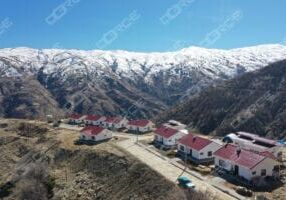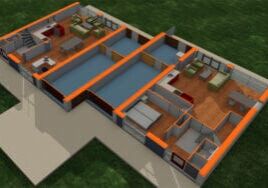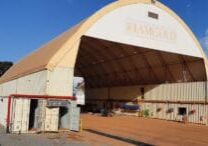DORCE Designs and Exports Volumetric Modular Buildings to 6 Continents
DORCE offers “Convertible and eco-friendly” volumetric modular steel structures
Today we witness “convertible and eco-friendly” volumetric modular buildings stand out in industrialized construction with new construction technologies, new construction methods, and innovative materials, unlike those used in traditional building systems.
Prefabricated modular building elements offer high-quality projects with lower costs and optimized & accelerated construction programs. The concepts such as Design for Manufacturing and Assembly (DfMA) & Designing for Industrialized Methods of Construction (DIMC) constitute the most basic and modern elements of Off-site construction and Modern Methods of Construction (MMC).
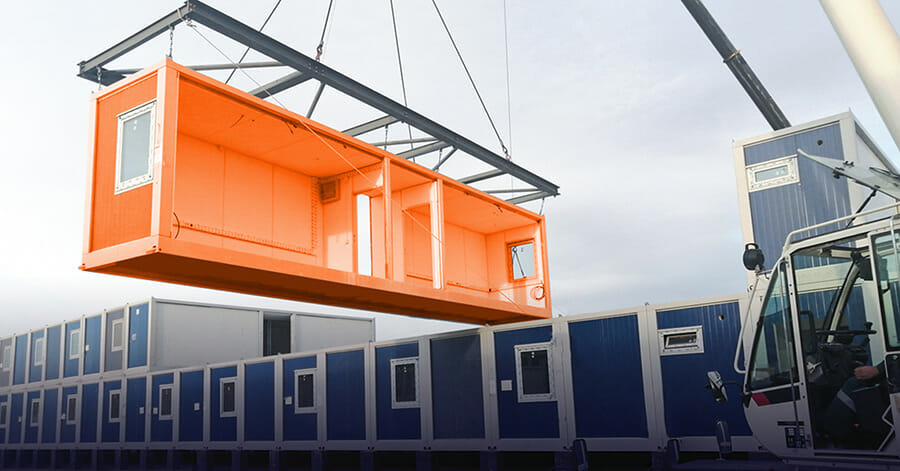
Demand has been increasing in sectors such as education, entertainment, health services, and housing
Mobile life offers fast and practical solutions with prefabricated modular structures to all the sudden and changing needs of people far away from their homes in the most severe climatic conditions. Stable architectural solutions used in built-in building systems have
begun to be replaced seriously by modular building systems. Demand for modular building systems has been increasing day by day in many areas of our lives such as education, entertainment, health services, and housing.
In general, modular building systems can be classified as permanent and mobile modular buildings.
Permanent modular buildings
Permanent modular buildings include schools, hospitals, shopping malls, clinics, residences, housing units, vehicle inspection stations, police stations, warehouses, hangars, administrative buildings, office buildings, hotels, and dormitories.
Mobile modular buildings
Mobile modular buildings include caravans, trailers, tiny houses, modular containers, temporary emergency & disaster facilities, integrated refugee facilities / camps, worker accommodation camps, labour quarters, and mobile hospitals.
Volumetric modular buildings of DORCE can be used as a traditional accommodation as well as temporary – volumetric modular accommodation in disaster and war zones; they are also used as temporary residential camps or permanent accommodation facilities at construction sites, oil & gas, mining, drilling, offshore and pipeline sites.
Related Reading:
Advantages of Digital Prefabrication for the Modern Construction Industry
DORCE Prefabricated Building & Construction Industry Trade Inc. manufactures prefabricated modular building components directly with Building Information Modeling (BIM) and completes their assemblies completely digitally off-site.
This article details all the benefits realized through digital prefabrication and shows how other manufacturers can capitalize on this popular method of project deisgn.
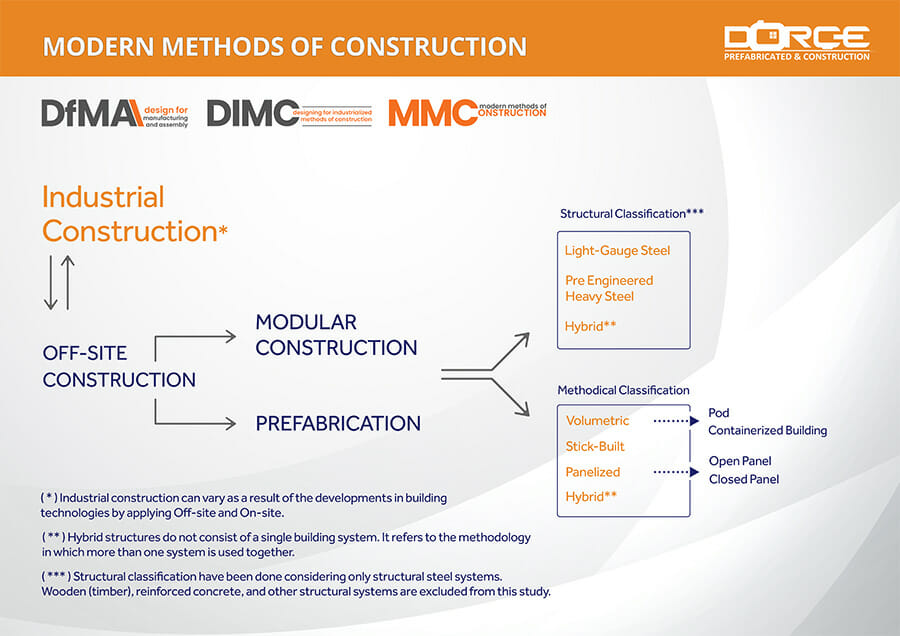
Modular units manufactured in a controlled environment
Modular building systems, manufactured by DORCE, are used for projects that require rapid solutions and must be completed in harsh climatic and geographical conditions. The component of modular buildings manufactured in a controlled environment at the industrialized facility (factory conditions) and transported to the construction site as units and assembled at the place.
DORCE completes staff accommodation facilities in Kazakhstan with volumetric modular building system
Last year, DORCE has successfully completed construction of Copper Mine Staff Accommodation Facilities within the scope of the Aktogay Expansion Project in Kazakhstan.
Pre-manufactured containerized modular units are manufactured at the Dorce production plant in Turkey, delivered as flat-packed and each module is assembled at Dorce workshops in Kazakhstan. Thereafter, modules delivered to the site in Aktogay and erected side by side and stacked to create a complete structure.
The connection of all modular buildings is done at the construction site. They are immediately made weathertight to protect the interior and interconnected structurally. The finishes and mechanical connections are completed, and all systems are inspected and tested. Custom features such as site applied finishes, pitched roofs and other architectural treatments can be added to make the building a customized structure, ideally suited for its specific use.
10 modular buildings with 1,628 modules in total
Finally, the entire structure composes of 10 modular buildings consisting of 1,628 modules in total.
Building modules are demountable, transportable, and designed to allow an easy dismantling and erection for several times. Volumetric modular buildings of DORCE are designed to be assembled on the reinforced concrete columns with anchorages above the ground level.
Off-site construction at -40 degrees climate conditions
These types of building systems allow the rapid formation of larger interior volumes and larger structures by coming together of modules as volumetric structures. Copper Mine Accommodation Facilities Project of DORCE in Kazakhstan – Aktogay was completed with “volumetric” building systems in -40 degrees climate conditions.
Volumetric modular building systems offer plenty of advantages
The advantage of this method is that all conditions are under control since the manufacturing process takes place in the factory environment. Thus, the quality of the produced materials increases. Fire, sound, and thermal insulation can be made as desired and accordingly with the requirements of projects and customers. In addition, this Modern Method of Construction (MMC) saves time.
Volumetric modular construction provides many advantages to people as a part of today’s modern living spaces and offer practical solutions in accordance with the changing needs of people. Volumetric modular buildings are permanent or temporary structures that can be equipped with high-level technology, meet their own needs, even solve their sub-structural needs such as energy recovery and waste recycling. They are lightweight, easily assembled and disassembled and transportable from one location to another.
More from Modular Advantage
DORÇE Navigates Mountainous Terrain, Extreme Weather to Help Rebuild Türkiye
The February 6 earthquakes in 2023 were enormous. In response, DORÇE moved quickly, obtaining a government bid to help create housing and multipurpose structures—both temporary and permanent—for earthquake victims and laborers hired for reconstruction efforts.
Modern Desert Oasis: Building Reset Hotel the Modular Way
While the off-site construction part of the Reset Hotel project has been carefully controlled and with every necessity close at hand at BECC Modular’s factory in Ontario, Canada, the remote location of the project site has created additional challenges for the on site portion of the build.
Revisiting Yellowstone Canyon Village—a Groundbreaking Modular Construction Feat—Ten Years On
With such a short building period due to impending cold, it made the most sense for park developer Xanterra to pursue modular. Yellowstone’s high visitor traffic also required some odd transportation scheduling, as traffic from the West Yellowstone entrance determined the times when trucks could unload modules. Guerdon was up to the challenge.
Built for Brutal Cold, This Modular Office Building Shines
Houlton, the county seat of Aroostook County, Maine, is a small town with a population of about 6,000 residents. Situated along the border between the U.S. and Canada, what the town is most known for is bitterly cold winters. When the U.S. Border Patrol needed new office space, a modular building approach from Modular Genius offered the perfect solution.
Panel Replacement Adds Years of Life to Navy Vessel
Panel Built, Inc., recently replaced all the wall and roof panels on a two-story US Navy barge deck house that the company had originally installed 30 years ago, giving the vessel new life. Now, the commanding officer of the unit that uses the barge said the difference between the condition and appearance from when the barge left their facility to when the project was complete was beyond his expectations of what was possible.
True Modular Building Seeks to Revolutionize Housing. It’s Next Stop: MBI’s World of Modular Europe
True Modular Building (TMB) specializes in crafting attainable, eco-friendly, and comfortable build-to-rent (BTR) housing with modern designs and customizable features, ensuring that residents feel at home both today and tomorrow.
From Toronto to Suriname: A Global Modular Building Story
When I AM Gold – a Canadian gold mining operation based in Toronto, Ontario – wanted to expand its mining operations in Suriname, it knew it would also need to expand its infrastructure. More specifically, they needed to build a mechanical services compound that would allow their local crews to maintain and equipment critical to their mining operations. They also knew that it would be a challenge.
There Were a “Sea of Challenges” for this Modular, Island Development
Question: Can modular construction be used to build a series of affordable, unique housing buildings, all styled to look like they were built in 1845, on an
island that caters to the wealthy? The answer is, of course, yes, but how the
team at Signature Building Systems and KOH Architecture got there is quite a story.
America’s Construction Economy: A Race Against Time
If the economy has been able to handle higher interest rates thus far, undoubtedly it will be able to manage the lower interest rates to come. But many economists are pointing out that the Federal Reserve may already be too late to the game. While they gradually reduce interest rates, the U.S. economy could quickly decelerate, at least based on theoretical grounds if not on the most recent data releases, culminating in that long-predicted recession. Only time will tell.
Top Five Benefits of Modular Office Space
Modular office spaces are transforming how businesses think about their work environments. These innovative structures offer a mix of flexibility, efficiency, and sustainability, making them a smart choice for companies looking to gain an advantage.

